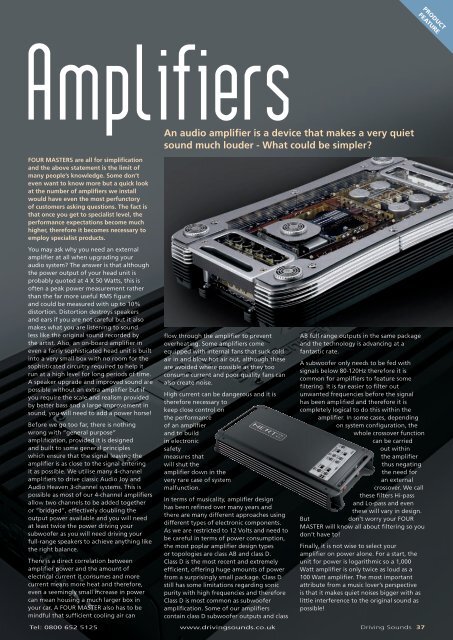For People Who Love Music On The Move - Four Masters
For People Who Love Music On The Move - Four Masters
For People Who Love Music On The Move - Four Masters
You also want an ePaper? Increase the reach of your titles
YUMPU automatically turns print PDFs into web optimized ePapers that Google loves.
Amplifiers<br />
An audio amplifier is a device that makes a very quiet<br />
sound much louder - What could be simpler?<br />
FOUR MASTERS are all for simplification<br />
and the above statement is the limit of<br />
many people’s knowledge. Some don’t<br />
even want to know more but a quick look<br />
at the number of amplifiers we install<br />
would have even the most perfunctory<br />
of customers asking questions. <strong>The</strong> fact is<br />
that once you get to specialist level, the<br />
performance expectations become much<br />
higher, therefore it becomes necessary to<br />
employ specialist products.<br />
You may ask why you need an external<br />
amplifier at all when upgrading your<br />
audio system? <strong>The</strong> answer is that although<br />
the power output of your head unit is<br />
probably quoted at 4 X 50 Watts, this is<br />
often a peak power measurement rather<br />
than the far more useful RMS figure<br />
and could be measured with up to 10%<br />
distortion. Distortion destroys speakers<br />
and ears if you are not careful but it also<br />
makes what you are listening to sound<br />
less like the original sound recorded by<br />
the artist. Also, an on-board amplifier in<br />
even a fairly sophisticated head unit is built<br />
into a very small box with no room for the<br />
sophisticated circuitry required to help it<br />
run at a high level for long periods of time.<br />
A speaker upgrade and improved sound are<br />
possible without an extra amplifier but if<br />
you require the scale and realism provided<br />
by better bass and a large improvement in<br />
sound, you will need to add a power horse!<br />
Before we go too far, there is nothing<br />
wrong with “general purpose”<br />
amplification, provided it is designed<br />
and built to some general principles<br />
which ensure that the signal leaving the<br />
amplifier is as close to the signal entering<br />
it as possible. We utilise many 4-channel<br />
amplifiers to drive classic Audio Joy and<br />
Audio Heaven 3-channel systems. This is<br />
possible as most of our 4-channel amplifiers<br />
allow two channels to be added together<br />
or “bridged”, effectively doubling the<br />
output power available and you will need<br />
at least twice the power driving your<br />
subwoofer as you will need driving your<br />
full-range speakers to achieve anything like<br />
the right balance.<br />
<strong>The</strong>re is a direct correlation between<br />
amplifier power and the amount of<br />
electrical current it consumes and more<br />
current means more heat and therefore,<br />
even a seemingly small increase in power<br />
can mean housing a much larger box in<br />
your car. A FOUR MASTER also has to be<br />
mindful that sufficient cooling air can<br />
flow through the amplifier to prevent<br />
overheating. Some amplifiers come<br />
equipped with internal fans that suck cold<br />
air in and blow hot air out, although these<br />
are avoided where possible as they too<br />
consume current and poor quality fans can<br />
also create noise.<br />
High current can be dangerous and it is<br />
therefore necessary to<br />
keep close control on<br />
the performance<br />
of an amplifier<br />
and to build<br />
in electronic<br />
safety<br />
measures that<br />
will shut the<br />
amplifier down in the<br />
very rare case of system<br />
malfunction.<br />
In terms of musicality, amplifier design<br />
has been refined over many years and<br />
there are many different approaches using<br />
different types of electronic components.<br />
As we are restricted to 12 Volts and need to<br />
be careful in terms of power consumption,<br />
the most poplar amplifier design types<br />
or topologies are class AB and class D.<br />
Class D is the most recent and extremely<br />
efficient, offering huge amounts of power<br />
from a surprisingly small package. Class D<br />
still has some limitations regarding sonic<br />
purity with high frequencies and therefore<br />
Class D is most common as subwoofer<br />
amplification. Some of our amplifiers<br />
contain class D subwoofer outputs and class<br />
Tel: 0800 652 5125 www.drivingsounds.co.uk<br />
PRODUCT<br />
FEATURE<br />
AB full range outputs in the same package<br />
and the technology is advancing at a<br />
fantastic rate.<br />
A subwoofer only needs to be fed with<br />
signals below 80-120Hz therefore it is<br />
common for amplifiers to feature some<br />
filtering. It is far easier to filter out<br />
unwanted frequencies before the signal<br />
has been amplified and therefore it is<br />
completely logical to do this within the<br />
amplifier. In some cases, depending<br />
on system configuration, the<br />
whole crossover function<br />
can be carried<br />
out within<br />
the amplifier<br />
thus negating<br />
the need for<br />
an external<br />
crossover. We call<br />
these filters Hi-pass<br />
and Lo-pass and even<br />
these will vary in design.<br />
But don’t worry your FOUR<br />
MASTER will know all about filtering so you<br />
don’t have to!<br />
Finally, it is not wise to select your<br />
amplifier on power alone. <strong>For</strong> a start, the<br />
unit for power is logarithmic so a 1,000<br />
Watt amplifier is only twice as loud as a<br />
100 Watt amplifier. <strong>The</strong> most important<br />
attribute from a music lover’s perspective<br />
is that it makes quiet noises bigger with as<br />
little interference to the original sound as<br />
possible!<br />
Driving Sounds 37


